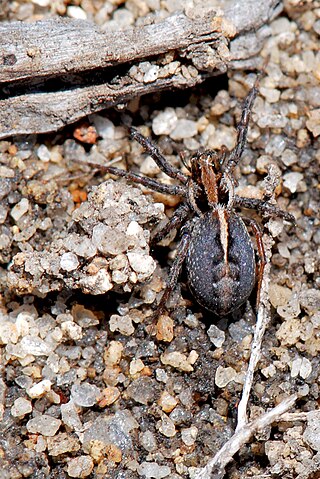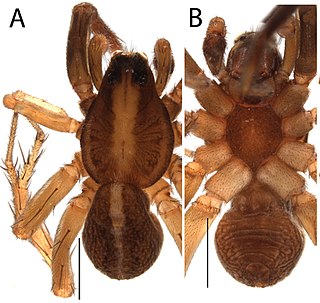
Wolf spiders are members of the family Lycosidae. They are robust and agile hunters with excellent eyesight. They live mostly in solitude, hunt alone, and usually do not spin webs. Some are opportunistic hunters, pouncing upon prey as they find it or chasing it over short distances; others wait for passing prey in or near the mouth of a burrow.
Nukuhiva is a genus of spiders with a single species, Nukuhiva adamsoni, that occurs only on the Marquesas Islands in French Polynesia. It is in the wolf spider family, Lycosidae. It has been found on Nuku Hiva and on Ua Huka, a smaller island about 25 km (16 mi) to the east.

The Artoriinae are a subfamily of wolf spiders. The monophyly of the subfamily has been confirmed in a molecular phylogenetic study, although the relationships among the subfamilies was shown to be less certain.

Artoriopsis is a genus of wolf spiders first described by Volker W. Framenau in 2007. It is endemic to Australia and is most diverse in the southern half of the continent, though A. anacardium is found in the tropical north of Australia. Its body size ranges from 3 to 11 mm, with males smaller than females. It appears to prefer open, vegetated or sandy areas of moderate humidity.

Artoriopsis expolita is a species of wolf spider from southern Australia, first described in 1877 by Ludwig Koch as Lycosa expolita.

Artoria is a genus of spiders in the family Lycosidae. It was first described in 1877 by Tamerlan Thorell, and the type species is Artoria parvula. In 1960, Roewer erected the genera Artoriella and Trabeola. However, in 2002, Volker Framenau reviewed Artoria and synonymised both these genera with Artoria.

Hoggicosa is a genus of wolf spiders first described by Carl Friedrich Roewer in 1960. The name is a reference to arachnologist Henry Roughton Hogg.
Barbara Baehr is a German research scientist, entomologist, arachnologist, and spider taxonomist. She has described over 400 new spider species, mostly from Australia. She is originally from Pforzheim, Germany.
Aname aragog is a species of trapdoor spider in the family Anamidae. It is found in the Pilbara region of Western Australia. The specific epithet is in reference to the spider Aragog in J.K. Rowling's Harry Potter books.

Venator is a genus of Australian wolf spiders first described by Henry Roughton Hogg in 1900. As of April 2019 it contains only three species.

Venator spenceri is a wolf spider, endemic to Australia and found in Queensland, New South Wales, Victoria, and South Australia.

Venator immansuetus is a wolf spider, endemic to Australia and found in the south-west of Western Australia.
Volker W. Framenau is a German-born Australian arachnologist and entomologist.

Aname marae is a species of mygalomorph spider in the Anamidae family. It is endemic to Australia. It was described in 2012 by Frances Harvey, Volker Framenau, Janine Wojcieszkek, Michael Rix and Mark Harvey. The specific epithet marae honours Mara Blosfelds, the mother of the senior author.
Aname baileyorum is a species of mygalomorph spider in the Anamidae family. It is endemic to Australia. It was described in 2020 by Mark Castalanelli, Volker Framenau, Joel Huey, Mia Hillyer and Mark Harvey.
Anomalosa oz is a spider in the Lycosidae family. It was first described in 2006 by Volker Framenau.
Anomalosa kochi is a spider in the Lycosidae family. It was first described in 1898 by Eugène Simon as Anomalomma kochi. In 1960, it was transferred to the genus Anomalosa by Carl Friedrich Roewer. The current description is given by Volker Framenau.

Artoria barringtonensis is a spider in the Lycosidae (wolf-spider family. It was first described in 2018 by Volker Framenau and Barbara Baehr.

Artoria belfordensis is a spider in the Lycosidae (wolf-spider family. It was first described in 2018 by Volker Framenau and Barbara Baehr.

Artoria beaury is a spider in the Lycosidae (wolf-spider family. It was first described in 2018 by Volker Framenau and Barbara Baehr.











